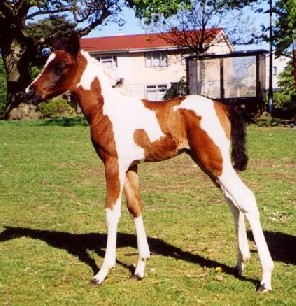genotype testing of tobiano horses
|
Homozygous and heterozygous tobiano horses are indistinguishable on the basis of phenotype (external appearance) alone. It is difficult to predict whether tobianos are true-breeding, even if they has two tobiano parents. If, on a cross to a solid colored horse, a solid foal is produced heterozygosity can be inferred. However the presence of only tobiano foals among a tobiano horses offspring doesn’t prove that the horse is true-breeding tobiano, especially if only a few foals have been produced. No direct DNA test for the tobiano gene is available yet, but “tobiano zygosity analysis” can be used to identify tobiano horses likely to be homozygous for the tobiano gene. Testing tobiano horses involves the use of genetic linkage analysis.
This means that most often the tobiano allele is linked to the "B" allele of Al and the "S" allele of Gc. There is some evidence that the gene combination is maintained in a chromosome inversion, with the inversion helping to conserve the linkage group. The alleles also appear in solid color horses, but the combination is significantly less frequent than in tobiano horses. For example consider tobiano horses with tobiano parents but of Quarter Horse descent. If they are homozygous for BB and SS, at Al and Gc respectively, they are five times more likely to be homozygous than to be heterozygous for tobiano. Blood typing required by the American Paint Horse Association for breeding stallions provides information on the genotype of those stallions at Al and Gc. Tobiano zygosity analysis uses information from blood testing of tobiano horses, along with information about their parents, and pedigree analysis. Evidence for tobiano homozygosity is based on analysing as much as possible of the following data: Phenotype: Tobiano. Homozygous horses often, but not always, have secondary spotting (ink spots, see main page on tobiano horses). Pedigree: Both parents should be tobiano. In the case of 2 heterozygous parents an average of 1 in 3 tobiano offspring would be homozygous. If one of the parents is heterozygous and one homozygous then 50% of offspring would be expected to be homozygous. Breeding data: Any solid colored foals born to tobiano horses are evidence of the heterozygous status of the parents.
genetic marker analysisThe dam and sire's blood types are compared to that of the horse being tested. The analysis is based on the assumption that no recombination occurs between the Al, Gc and TO loci, and therefore can not be accurate in 100% of cases. If both parents are known to be heterozygous for tobiano, and both are BB or AB at the Al locus and FS at the Gc locus then their BB, SS tobiano offspring are highly likely to be homozygous for tobiano (greater than 90% chance). This is based on the linkage disequilibrium between the loci and the TO locus. Further evidence from breeding results or studbook data will be needed for zygosity determination. Occasionally a conclusive analysis can’t be made. If either parent is heterozygous for tobiano and of genotype BB and SS at Al and Gc respectively then the marker testing is inconclusive, with the horse equally likely to be homozygous or heterozygous. The examples below shows how data can be interpreted, along with what can and can’t be determined. The genotypes are given in the order Al, Gc and TO, although the true order, in terms of the loci’s physical location on the chromosomes, is unknown. Where the identity of a tobiano allele is unknown the allele is represented by the underscore character ( _ ).
A stallion of genotype AB,FS,To_ has sired two foals by each of two mares. Mare A has genotype AA,FF,toto and is therefore solid colored. She has one foal of each type (solid and tobiano). From this we can infer that the stallion is heterozygous, since the solid foal must’ve inherited to from his dad. The solid foals genotype is AA,FF,toto. From this we infer the linkage phase of the stallion: the stallion must have alleles A,F and to linked on one chromosome and alleles B,S and To on the other. This is confirmed by the fact that the mares other (tobiano) foal by the same stallion has genotype AB,FS,Toto (B,S,To must have been inherited from the sire in this case). Mare B is tobiano, with genotype AB,FS,To_ and one foal of each type. The question is whether the tobiano foal is true-breeding tobiano or heterozygous (Toto). The solid foal is AA,FF,toto, indicating that the mare is heterozygous, and that in the mare one linkage group is A,F,to and the other B,S,To. The tobiano foal has genotype BB,SS,To_. Since in both its dam and sire B and S are linked to To it is highly likely that the tobiano foal is homozygous at the TO locus, and therefore would produce or sire 100% tobiano foals. We note also that this is what would be expected from the foals phenotype and Al and Gc genotype alone.
The same tobiano stallion has sired a foal by a tobiano mare of genotype BB,SS,To_. The breeder wishes to know if her tobiano colt foal is true-breeding. The mare has previously had a solid foal of unknown genotype, by a stallion, also of unknown genotype. This does however indicate that the mare is heterozygous at the TO locus, and must have one chromosome of linkage group B,S,To and one of B,S,to. In this case then, despite genotype BB,SS usually being associated with homozygosity at the TO locus (i.e. ToTo), this foal is equally likely to be heterozygous or true-breeding for tobiano. We note that this is the opposite to what would be expected from the foals phenotype and Al and Gc genotype alone, due to rare crossing over within the linkage group.
ReferencesBowling, A.T. 1987. Equine linkage group II: phase conservation to TO with Al:B and Gc:S. Journal of Heredity 78, 248-250. Bowling, Ann T. 1996. Horse Genetics. CAB International. ISBN 0 851991017.
back to page on tobiano horses
|
|








